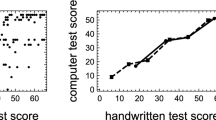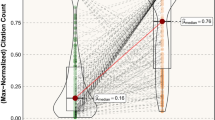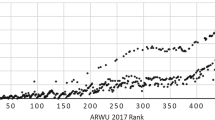Abstract
Variation of citation counts by subdisciplines within a particular discipline is known but rarely systematically studied. This paper compares citation counts for award-winning mathematicians is different subdisciplines of mathematics. Mathematicians were selected for study in groups of rough equivalence with respect to peer evaluation, where this evaluation is given by the awarding of major prizes and grants: Guggenheim fellowships, Sloan fellowships, and National Science Foundation CAREER grants. We find a pattern in which mathematicians working in some subdisciplines have fewer citations than others who won the same award, and this pattern is consistent for all awards. So even after adjustment at the discipline level for different overall citation rates for disciplines, citation counts for different subdisciplines do not match peer evaluation. Demographic and hiring data for mathematics provides a context for a discussion of reasons and interpretations.



Similar content being viewed by others
Notes
The NRC surveyed faculty members on 21 possible variables. “[Faculty survey responses] were generally in agreement that publications and citations were the most important factors in program quality.” (National Research Council 2010, p. 12.) Citations were third behind publications per faculty and grants for mathematics and applied mathematics. (National Research Council 2010, Appendix F.)
Excluded items include Database Expansion Items, which represent an expansion of the scope of coverage. Database Expansion items have included “journal publications in the areas that might be termed Applied Statistics” and “Computer Science not previously considered to be within the scope of the MR Database.” In addition, “various digitization projects around the world are invited to contribute their bibliographic data,” but are not classified (AMS 2011a).
While Math Ed is included as a discipline, JRC Education and Educational Research journals are not included in MathSciNet. We will not consider the subdisciplines of Math Ed and Other.
Information is from the combined membership list downloaded from www.ams.org/cml on October 25, 2010.
Group Vb is no longer surveyed but, contained management science and operations research.
Omitted are the 1,231 departments classified as Group M or Group B composed of U.S. departments granting at most a baccalaureate or master’s degree.
For example, the two largest groups named above are 13 Wolf prize and 10 Fields medal recipients. The Fields medalists were all 40 years of age or younger when receiving their awards in the last decade (a homogeneous group in length of career but a small group) while the 13 Wolf prize recipients are all seniors and, in fact, included six Fields medalists from 1966 to 1982.
The NSF CAREER grant is used by the AAU (2000). See AAU Membership Policy Attachment 1: List of Awards, Fellowships and Memberships labeled as “Collected by The Center for Measuring University Performance.” The NRC only includes PECASE awards, which, in mathematics, are primarily a small subset of CAREER awards.
References
American Mathematical Society (AMS). (2011a). MR: Help. Retrieved August 2, 2011 from http://www.ams.org/mathscinet/help/citation_database_help_full.html.
American Mathematical Society (AMS). (2011b). Annual survey of the mathematical sciences. Retrieved from http://www.ams.org/profession/data/annual-survey/annual-survey.
American Mathematical Society (AMS). (2011c). Math reviews institution codes and addresses look up. Retrieved August 2, 2011 from http://www.ams.org/instcode.
Association of American Universities (AAU). (2000). AAU Membership Policy. Retrieved August 2, 2011 from http://www.aau.edu/WorkArea/DownloadAsset.aspx?id=10972.
Bensman, S. J. (2008). Distributional differences of the impact factor in the sciences versus the social sciences: An analysis of the probabilistic structure of the 2005 Journal Citation Reports. Journal of the American Society for Information Science and Technology, 60(6), 1097–1117.
Bensman, S. J., Smolinsky, L. J., & Pudovkin, A. I. (2010). Mean citation rate per article in mathematics journals: Differences from the scientific model. Journal of the American Society for Information Science, 61(2010), 1440–1463.
Bornmann, L., & Daniel, H. D. (2006). What do citation counts measure? A review of studies on citing behavior. Journal of Documentation, 64(1), 45–80.
Bornmann, L., Mutz, R., Marx, W., Schier, H., & Daniel, H. D. (2011a). A multilevel modelling approach to investigating the predictive validity of editorial decisions: Do the editors of a high profile journal select the manuscripts that are highly cited after publication? Journal of the Royal Statistical Society A, 174(4), 857–879.
Bornmann, L., Schier, H., Marx, W., & Daniel, H. D. (2011b). Is interactive open access publishing able to identify high-impact submissions? A study on the predictive validity of atmospheric chemistry and physics by using percentile rank classes. Journal of the American Society for Information Science and Technology, 62(1), 61071.
Davis, P. M. (2009). Reward or persuasion? The battle to define the meaning of a citation. Learned Publishing, 22(1), 5–11.
Fairweather, G., & Wegner, B. (2009). For your information: mathematics subject classification 2010. Notices of the American Mathematical Society, 56(7), 848.
Garfield, E. (1979). Citation indexing—Its theory and application in science, technology, and humanities. New York: Wiley.
Glänzel, W., & Schubert, A. (2003). A new classification scheme of science field and subfields designed for scientometric valuation purposes. Scientometrics, 56(3), 357–367.
Grcar, J. F. (2010). Topical bias in generalist mathematics journals. Notices of the American Mathematical Society, 57(11), 1421–1424.
Lewison, G., & Dawson, G. (1998). The effect of funding on the outputs of biomedical research. Scientometrics, 41(1–2), 17–27.
MacRoberts, M. H., & MacRoberts, B. R. (1996). Problems of citation analysis. Scientometrics, 36(3), 435–444.
MacRoberts, M. H., & MacRoberts, B. R. (2010). Problems of citation analysis: A study of uncited and seldom-cited influences. Journal of the American Society for Information Science and Technology, 61(1), 1–13.
MathSciNet books. (2009). Retrieved August 2, 2011 from http://www.ams.org.libezp.lib.lsu.edu/mathscinet/.
MathSciNet papers. (2009). Retrieved August 2, 2011 from http://www.ams.org.libezp.lib.lsu.edu/mathscinet/.
Moed, H. (2005). Citation analysis in research evaluation. Dordrecht: Springer.
National Research Council (NRC). (2010). A revised guide to the methodology of the data-based assessment of research-doctorate programs in the United States. Washington, DC: The National Academies Press.
National Research Council (NRC). (2011a). A data-based assessment of research-doctorate Programs in the United States. Washington, DC: The National Academies Press.
National Research Council (NRC). (2011b). Assessment of research doctorate programs. Awards and honors data Collection and Methodology. Retrieved August 2, 2011 from http://sites.nationalacademies.org/PGA/Resdoc/PGA_044718.
National Science Board (NSB). (2010). Science and Engineering Indicators 2010. Arlington: National Science Foundation (NSB 10-01).
Nicolaisen, J. (2007). Citation analysis. Annual Review of Information Science and Technology, 41, 609–641.
Podlubny, I. (2005). Comparison of scientific impact expressed by the number of citations in different fields of science. Scientometrics, 64(1), 95–99.
Podlubny, I., & Kassayova, K. (2006). Towards a better list of citation superstars: compiling a multidisciplinary list of highly cited researchers. Research and Evaluation, 13(3), 154–162.
Podlubny, I., & Kassayova, K. (2011). The law of constant ratio. Letters to the editor. Notices of the American Mathematical Society, 58(5), 653–654.
Radicchi, F., & Castellano, C. (2011). Rescaling citations of publications in physics. Physical Review E, 83(4), 046116.
Radicchi, F., Fortunato, S., & Castellano, C. (2008). Universality of citation distributions: Toward an object measure of scientific impact. Proceedings of the National Academy of Science of the United States, 105(45), 17268–17272.
Seglen, P. Q. (1992). The skewness of science. Journal of the American Society for Information Science, 43, 628–638.
Society for Industrial and Applied Mathematics (SIAM). (2011). Prizes, awards, and lectures sponsored by SIAM. Retrieved August 2, 2011 from http://www.siam.org/prizes/sponsored/.
Taborsky, M. (2009). Biased citation practice and taxonomic parochialism. Ethology, 115, 105–111.
Thomson Reuters. (2011). Science citation index expanded scope notes, Retrieved August 2, 2011 from http://science.thomsonreuters.com/mjl/scope/scope_scie/.
Author information
Authors and Affiliations
Corresponding author
Rights and permissions
About this article
Cite this article
Smolinsky, L., Lercher, A. Citation rates in mathematics: a study of variation by subdiscipline. Scientometrics 91, 911–924 (2012). https://doi.org/10.1007/s11192-012-0647-3
Received:
Published:
Issue Date:
DOI: https://doi.org/10.1007/s11192-012-0647-3




